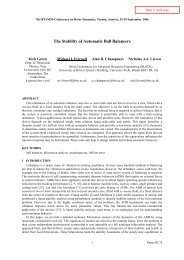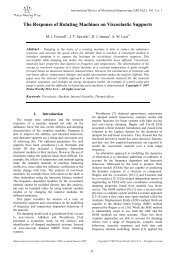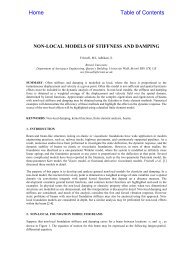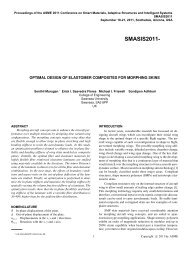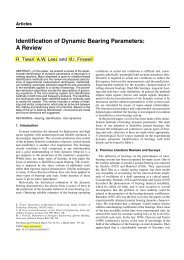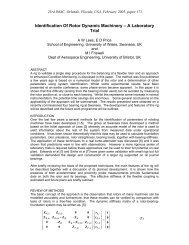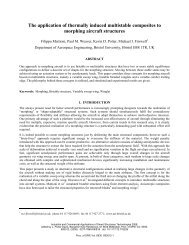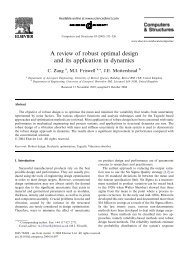Modelling Continuously Morphing Aircraft for ... - Michael I Friswell
Modelling Continuously Morphing Aircraft for ... - Michael I Friswell
Modelling Continuously Morphing Aircraft for ... - Michael I Friswell
You also want an ePaper? Increase the reach of your titles
YUMPU automatically turns print PDFs into web optimized ePapers that Google loves.
where<br />
M A =<br />
K A =<br />
e ext =<br />
e V =<br />
e ∆T =<br />
∫∫<br />
S T S ̺ t dx dy (59)<br />
S<br />
∫∫<br />
A E T Q E t dx dy (60)<br />
S<br />
∫∫<br />
A S T f ext dx dy (61)<br />
S<br />
(∫∫<br />
A )<br />
E T Q T(θ) −1 dx dy b V (62)<br />
S<br />
(∫∫<br />
A )<br />
E T Q T(θ) −1 t dx dy b ∆T (63)<br />
S A<br />
where M A and K A are the mass and stiffness contributions of the strain actuator to be added to the total<br />
mass and stiffness matrices of the structure, while e V and e ∆T are the generalized vectors providing to the<br />
structure the effect of an applied voltage and a temperature variation, respectively. If N A actuators are<br />
placed over the wing surface, the contribution of each actuator has to be included. If the patch dimensions<br />
are small compared to the whole skin area, then the previous equations can be discretized and evaluated<br />
with respect to the centre point coordinates of the patch, namely x A , y A and z A . For instance Eq. (59)<br />
becomes<br />
M A = S(x A , y A , z A ) T S(x A , y A , z A ) ̺ t a b (64)<br />
where a and b are the width and length of the patch, supposed to be rectangular.<br />
III.A.<br />
Validation via Thermal Analogy<br />
The strain actuation theory developed in the previous section will be validated taking into account only a<br />
static thermal load distribution and results from a finite element thermal analysis will be used <strong>for</strong> comparison.<br />
The validity of the method <strong>for</strong> the piezo patches can be easily extended using the thermal analogy. 35<br />
The wing box chosen as a test case is the same as in Sec. II.E <strong>for</strong> the 30 ◦ back-swept case. Indeed, the<br />
same NASTRAN finite element model is adopted.<br />
A distribution of thermal load is applied all over the upper skin (see Fig. 7). Specifically, the difference<br />
in temperature ∆T follows a quadratic law along the span, with maximum value at the mid-span, while no<br />
dependency is assumed along the chord direction, and thus<br />
[ ( y<br />
) ( ] y 2<br />
∆T(x, y) = 4∆T ∗ −<br />
(65)<br />
L L)<br />
where ∆T ∗ is the maximum value of the temperature field, occurring at y = L/2.<br />
In NASTRAN this has been done, within the static SOL 101 solver, via the TEMP card which allows an<br />
absolute temperature to be imposed at each nodes. However the reference temperature value, at which the<br />
coefficient of thermal expansion is evaluated (α 1 = α 2 = 23 × 10 −6 K −1 at 20 ◦ <strong>for</strong> Aluminium), has to be<br />
set in the MAT1 card. The equivalent plate thermal load model is obtained by discretisating the continuous<br />
distribution in Eq. (65), as described in III.<br />
Since the system is linear, results corresponding to a ∆T ∗ parameter equal to the unitary value are<br />
presented. In Fig. 8 the vertical displacements of the points belonging to the upper skin, both along<br />
the chord section at the half span and the section at the tip, are shown. Indeed, in Fig. 9 the vertical<br />
displacements of the points of the front and rear spar, belonging to the medium plane, are plotted. In the<br />
same figures, the displacements evaluated with the equivalent plate approach are compared with those from<br />
NASTRAN. The results are in good agreement, as the MAC (Modal Assurance Criterion) and the the MSF<br />
(Modal Scale Factor) between the two de<strong>for</strong>mation shapes are both equal to 0.97. Finally in Fig. 10, the<br />
von Mises stresses of points belonging to the upper skin above the elastic line, are plotted. Again the results<br />
are in good agreement and the maximum stress value is identified by the equivalent plate theory with an<br />
error of 0.8% relative to the NASTRAN prediction.<br />
14 of 23<br />
American Institute of Aeronautics and Astronautics




